Study of Retention of Drilling Fluid Layer on Annulus Wall during Cementing
Abstract
1. Introduction
2. Assumption and Description of Calculation Model
- (1)
- Take the wellbore annulus, whose length is one casing column, as the object, and regard the entire annulus as consisting of (countless) two flat plates with variable width;
- (2)
- The flow pattern of cement displacement process is a laminar flow, and the flow rate of cement slurry displacement is constant;
- (3)
- Both cement slurry and drilling fluid satisfy the Hershel–Bulkley rheological model;
- (4)
- During cement replacement, the mixing of cement slurry and drilling fluid at the interface is neglected; also, the physical and chemical reactions between cement slurry and drilling fluid at the interface are not considered;
- (5)
- The shear stress acting on drilling fluid is mainly generated by the axial flow of cement slurry; thus, the circumferential velocity gradient is neglected;
- (6)
- The influence of mud cake is not considered.
3. Analysis of Shear Stress Distribution Characteristics of Annulus Fluid
3.1. Differential Equation of Shear Stress Distribution of Annulus Fluid
3.2. Definite Solution Conditions and Dimensionless Treatment of Rheological Model
3.3. Analysis on the Distribution Characteristics of Annular Fluid Shear Stress
4. Calculation Model of Drilling-Fluid-Retention-Layer Thickness
5. Calculation and Analysis of Thickness of Drilling Fluid Retention Layer
5.1. Effect of Various Factors on the Thickness of Drilling Fluid Retention Layer
5.1.1. Effect of Drilling Fluid Yield Stress
5.1.2. Effect of Yield Stress of Cement Slurry
5.1.3. Effect of Consistency Coefficient of Cement Slurry
5.1.4. Effect of Density Difference of Drilling Fluid
5.1.5. Effect of Well Inclination Angle
5.2. Analysis on Thickness of Drilling Fluid Retention Layer in Eccentric Annulus
6. Quantitative Conditions for Absence of Drilling Fluid Retention on the Wall
7. Case Analysis
8. Conclusions
- (1)
- The characteristics of annulus fluid shear stress distribution are analyzed. Equations (7)–(9) suggest that if the yield stress of the drilling fluid exceeds that of the cement slurry, and the shear stress at the wall is lower than the yield stress of the drilling fluid, a specific thickness of drilling fluid retention layer will develop on the annulus wall.
- (2)
- The calculation model for the thickness of the drilling fluid retention layer is established, and the thickness of the drilling fluid retention layer is analyzed with parameters of wellbore and fluid performance: , , , , , . The thickness of the drilling fluid retention layer is positively correlated with the drilling fluid yield stress and well inclination angle, while it is negatively correlated with the cement slurry yield stress, consistency coefficient of the cement slurry, and the density difference between the drilling fluid and cement slurry.
- (3)
- The thickness of drilling fluid retention layer in eccentric annulus is analyzed (i.e., eccentricity of 0, 0.1, 0.2, 0.3 are used). When the casing is not centered, the thickness of the layer of drilling fluid retained is smaller at the wider annulus gap and larger at the narrower annulus gap. As casing eccentricity increases, the disparity in the thickness of the drilling fluid retention layer between the wide and narrow gaps also increases.
- (4)
- The quantitative conditions for preventing drilling fluid retention is established (i.e., Equation (23)). Based on Equation (23), a case study is conducted to show in which case the retention of drilling fluid can occur. When the parameters (A, B) are located at the lower part of the curve, the drilling fluid is retained; when (A, B) is located at the upper part of the curve, there is no retention of drilling fluid. The suggested theoretical framework can provide guidance for determining a set of cementing parameters, including displacement capacity, drilling fluid density, cement slurry density, plastic viscosity, yield stress, liquidity index, and consistency coefficient, based on a specific set of well parameters.
Author Contributions
Funding
Data Availability Statement
Conflicts of Interest
Nomenclature
| H | half of the dimensionless annular-clearance width at a certain circumferential angle |
| B | the length of the dimensionless ring gap at a circumferential angle |
| Yi | the contact surface between cement slurry and drilling fluid, and 0 < Yi ≤ H. |
| well depth | |
| ξ | dimensionless well depth |
| θ | circumferential angle of annular space |
| β | borehole well inclination, ° |
| the inner diameter of the borehole | |
| the outer diameter of the casing | |
| W(y) | the dimensionless velocity of the fluid |
| 1 | yield stress |
| 2 | shear stress of cementing slurry or drilling fluid |
| b | shear stress of the fluid at the wall of two flat plates |
| Yi | shear stress of the fluid at the contact surface Yi |
| hsta | the thickness of the drilling fluid retention layer |
| ŵ* | cement slurry injection rate |
| ŵ(ŷ) | cement slurry displacement rate |
| m1 | the reciprocal of cement slurry liquidity index |
| Parameter A | the ratio of cement slurry yield stress to drilling fluid yield stress |
| parameter B | the ratio of cement slurry yield stress to cement slurry consistency coefficient |
References
- Zheng, Y.; Fang, D.; Hao, J. A theoretical and experimental study of cementing for horizontal well. J. Hydrodyn. 1996, 11, 19–23. [Google Scholar]
- Cao, L.; Sun, J.; Zhang, B.; Lu, N.; Xu, Y. Sensitivity analysis of the temperature profile changing law in the production string of a high-pressure high-temperature gas well considering the coupling relation among the gas flow friction, gas properties, temperature, and pressure. Front. Phys. 2022, 10, 1050229. [Google Scholar] [CrossRef]
- Pelipenko, S.; Frigaard, I.A. On steady state displacement in primary cementing of an oil well. J. Eng. Math. 2004, 48, 1–32. [Google Scholar] [CrossRef]
- Bittleston, S.H.; Frigaard, I.A. Mud removal and cement placement during primary cementing of an oil well: Steady-state displacements. J. Eng. Math. 2004, 48, 1–26. [Google Scholar] [CrossRef]
- Frigaard, I.A.; Pelipenko, S. Effective and Ineffective Strategies for Mud Removal and Cement Slurry Design. In Proceedings of the SPE Latin American and Caribbean Petroleum Engineering Conference, Port-of-Spain, Trinidad and Tobago, 27–30 April 2003. SPE-80999-MS. [Google Scholar]
- Bittleston, S.H.; Ferguson, J.; Frigaard, I.A. Mud removal and cement placement during primary cementing of an oil well: Laminar non-Newtonian displacements in an eccentric annular Hele-Shaw cell. J. Eng. Math. 2002, 43, 229–253. [Google Scholar] [CrossRef]
- Beirute, R.M.; Flumerfelt, R.W. Mechanics of the Displacement Process of Drilling Muds by Cement Slurries Using an Accurate Rheological Model. In Proceedings of the SPE Annual Fall Technical Conference and Exhibition, Denver, CO, USA, 9–12 October 1977. SPE-6801-MS. [Google Scholar]
- Li, M.; Wang, C.; Guo, S.; Fang, Q. Numerical simulation of cement displacement in eccentric annulus at highly deviated wells. J. Pet. Drill. Tech. 2012, 40, 40–44. [Google Scholar]
- Yang, J.; Deng, J.; Feng, Y. Numerical simulation of effect of density difference on displacement efficiency at low cement slurry velocity. Pet. Drill. Tech. 2008, 36, 62–65. [Google Scholar]
- Couturier, M.; Guillot, D.; Hendriks, H.; Callet, F. Design rules and associated spacer properties for optimal mud removal in eccentric annuli. In Proceedings of the PETSOC Annual Technical Meeting, Calgary, AB, Canada, 9–12 June 1990. PETSOC-90-112. [Google Scholar]
- Lockyear, C.F.; Hibbert, A.P. Integrated primary cementing study defines key factors for field success. J. Pet. Technol. 1989, 41, 1320–1325. [Google Scholar] [CrossRef]
- Eslami, A.; Akbari, S.; Taghavi, S.M. An experimental study of displacement flows in stationary and moving annuli for reverse circulation cementing applications. J. Pet. Sci. Eng. 2022, 213, 110321. [Google Scholar] [CrossRef]
- Frigaard, I.A.; Renteria, A.; Sarmadi, P. Primary cementing of horizontal wells. Displacement flows in eccentric horizontal annuli. Part 2. Computations. J. Fluid Mech. 2021, 915, A83. [Google Scholar]
- Saasen, A.; Ytrehus, J.D. Rheological Properties of Drilling Fluids: Use of Dimensionless Shear Rates in Herschel-Bulkley and Power-law Models. Appl. Rheol. 2018, 28, 201854515. [Google Scholar]
- Saasen, A.; Ytrehus, J.D. Viscosity Models for Drilling Fluids—Herschel-Bulkley Parameters and Their Use. Energies 2020, 13, 5271. [Google Scholar] [CrossRef]
- Haut, R.C.; Crook, R.J. Primary Cementing: The Mud Displacement Process. In Proceedings of the SPE Annual Technical Conference and Exhibition, Las Vegas, NV, USA, 23–26 September 1979. [Google Scholar]
- Kroken, W.; Sjaholm, A.J.; Olsen, A.S. Tide Flow: A Low Rate Density Driven Cementing Technique for Highly Deviated Wells. In Proceedings of the IADC/SPE Drilling Conference, New Orleans, LA, USA, 12–15 March 1996. [Google Scholar]
- Tardy, P.M.; Flamant, N.C.; Lac, E.; Parry, A.; Sutama, C.S.; Almagro, S.P. New Generation 3D Simulator Predicts Realistic Mud Displacement in Highly Deviated and Horizontal Wells. In Proceedings of the SPE/IADC Drilling Conference and Exhibition, The Hague, The Netherlands, 14–16 March 2017. [Google Scholar]
- Tardy, P.M.J. A 3D model for annular displacements of wellbore completion fluids with casing movement. J. Pet. Sci. Eng. 2018, 162, 114–136. [Google Scholar] [CrossRef]
- Yang, M.; Yang, L.; Li, Y.; Zhang, L.; Wang, C.; Zhou, L.; Yang, M. Improving displacement efficiency by optimizing pad fluid injection sequence during primary cementing of eccentric annulus in shale gas horizontal wells. J. Pet. Sci. Eng. 2021, 204, 108691. [Google Scholar] [CrossRef]
- Carrasco-Teja, M.; Frigaard, I.A.; Seymour, B. Cementing Horizontal Wells: Complete Isolution without Casing Rotation. In Proceedings of the SPE Unconventional Resources Conference/Gas Technology Symposium, Calgary, AB, Canada, 16–19 June 2008. SPE-114955-MS. [Google Scholar]
- Liao, H.L.; Li, G.S.; Zhang, S.K. Theoretical analysis of cementing displacement mechanics of laminar flow for slim-hole. Pet. Drill. Tech. 2003, 31, 30–32. [Google Scholar]

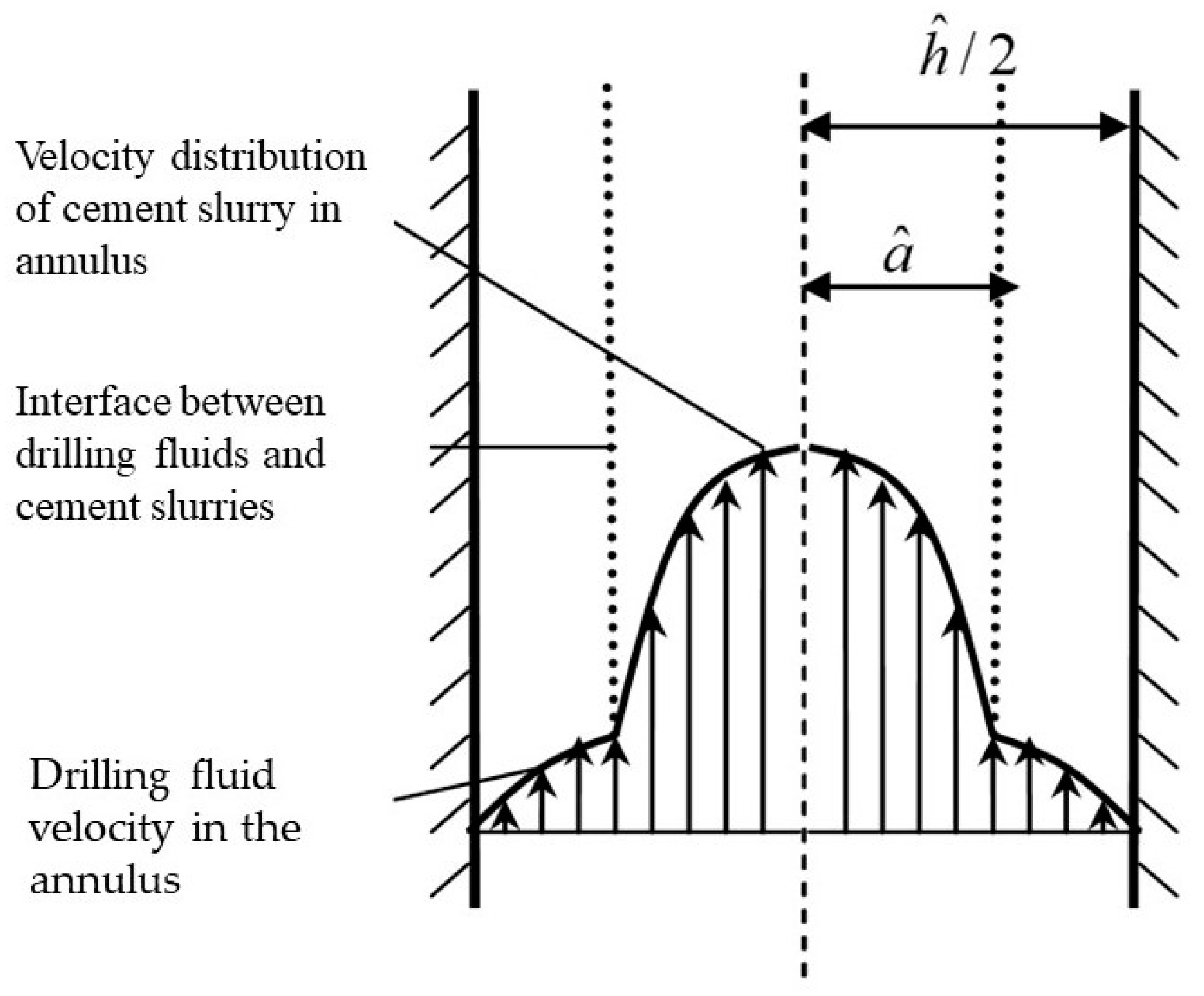
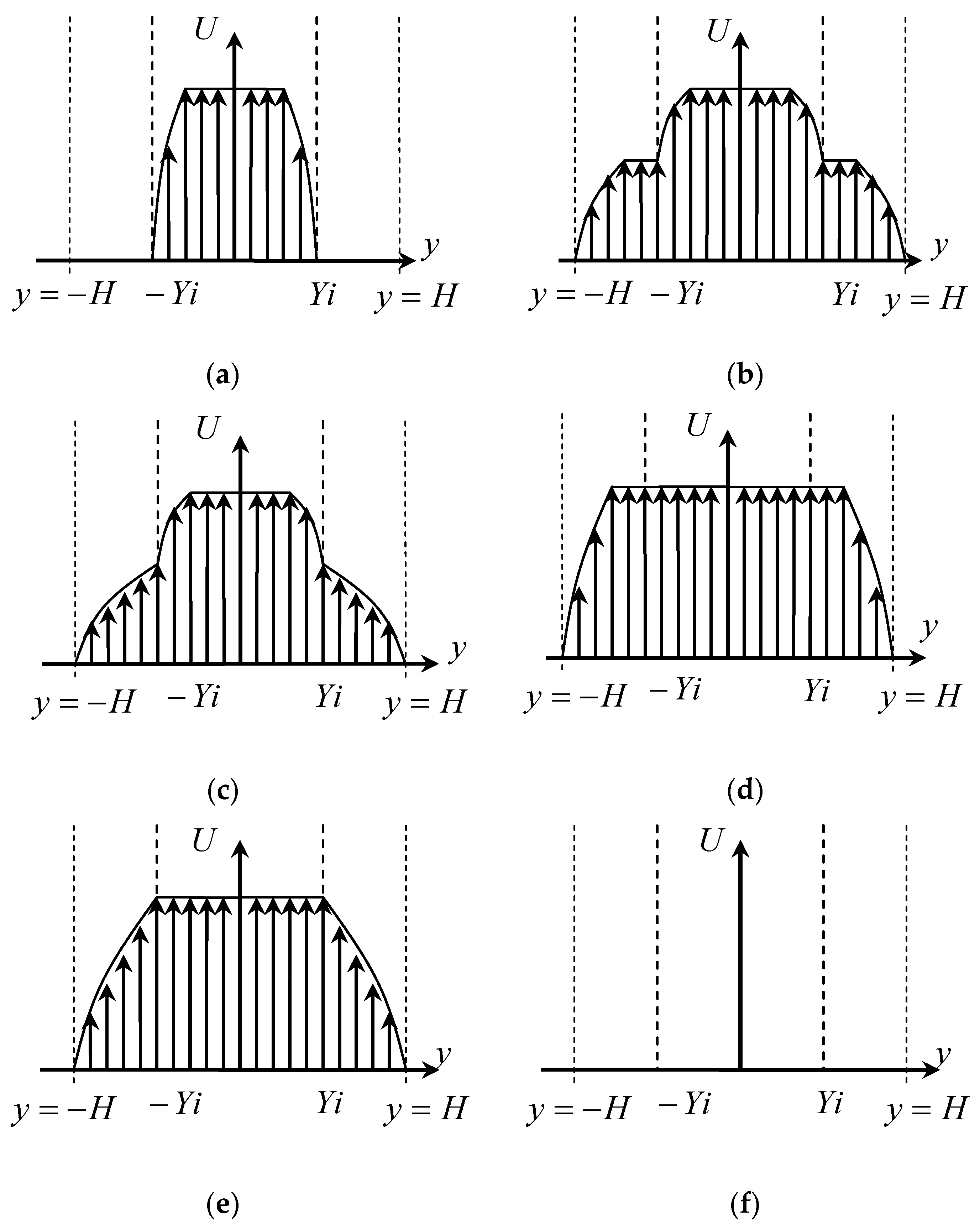


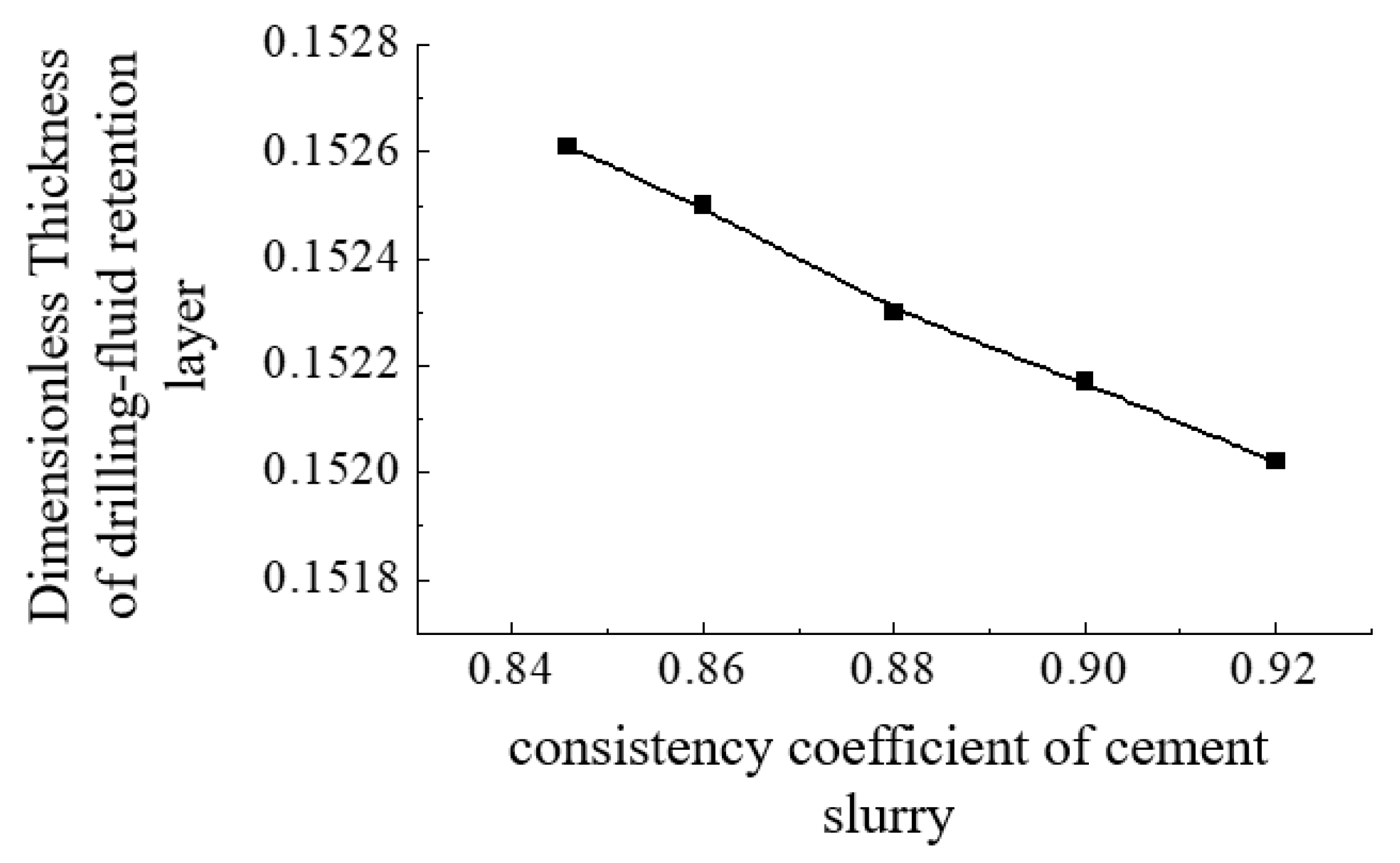

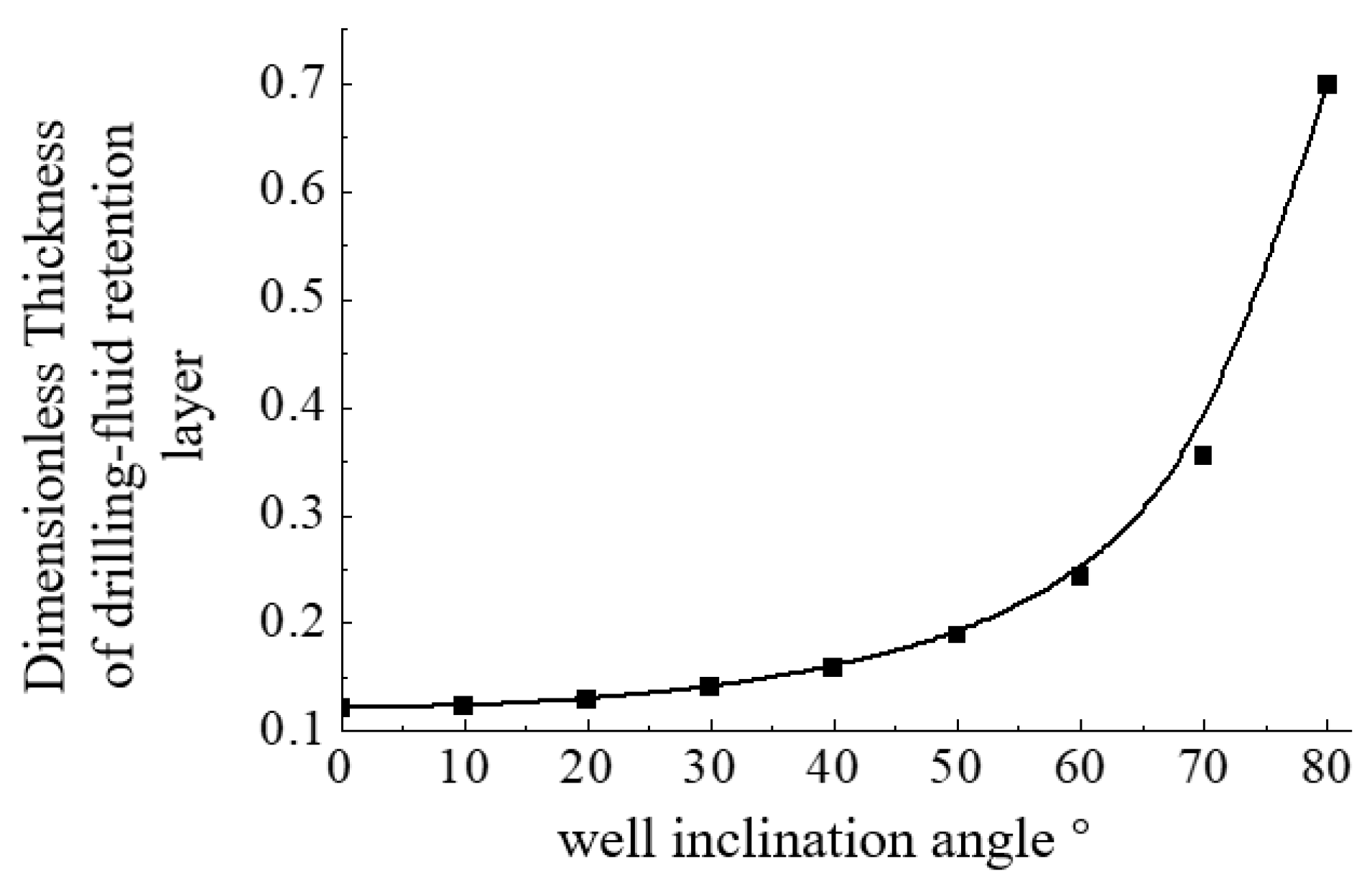

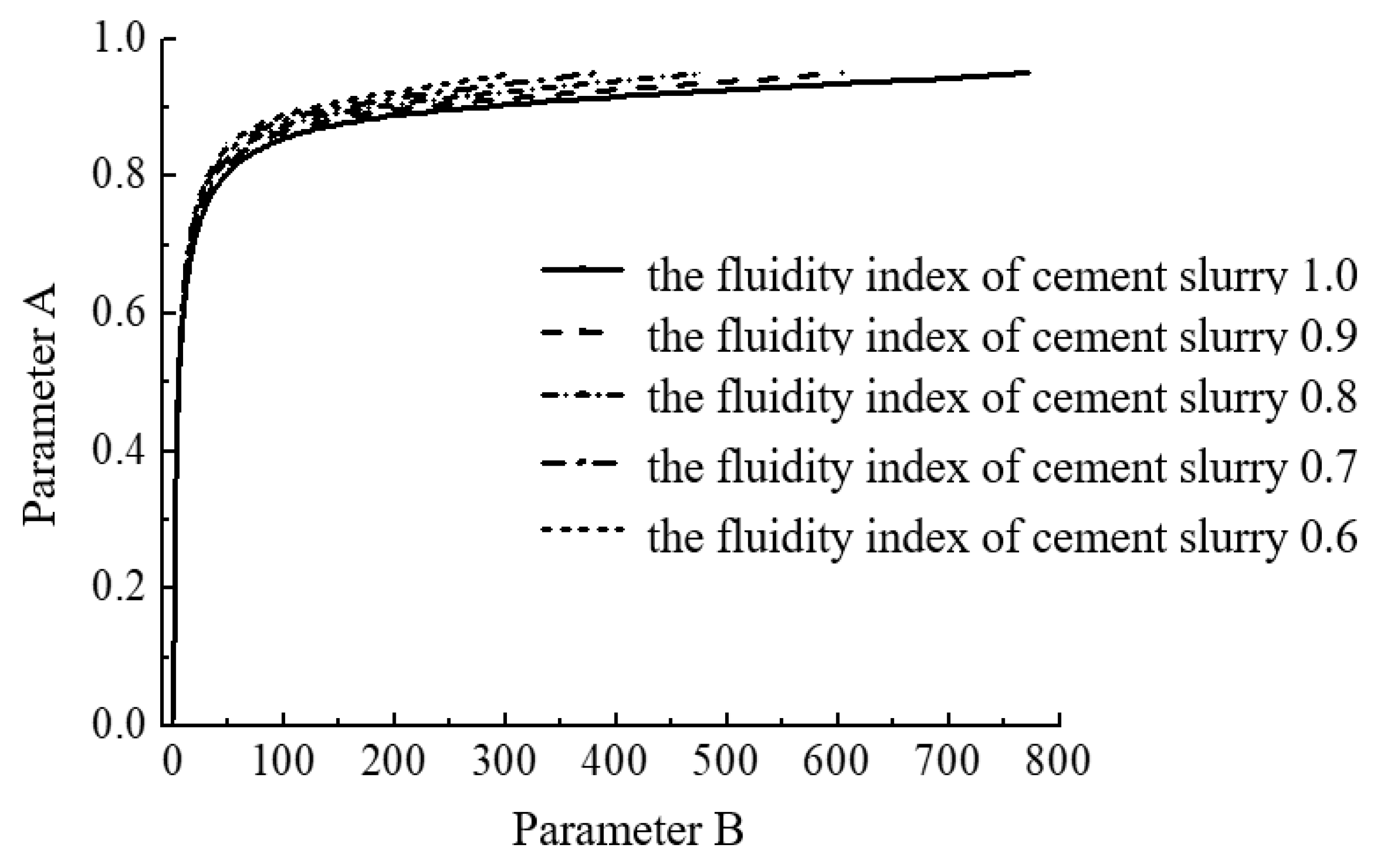



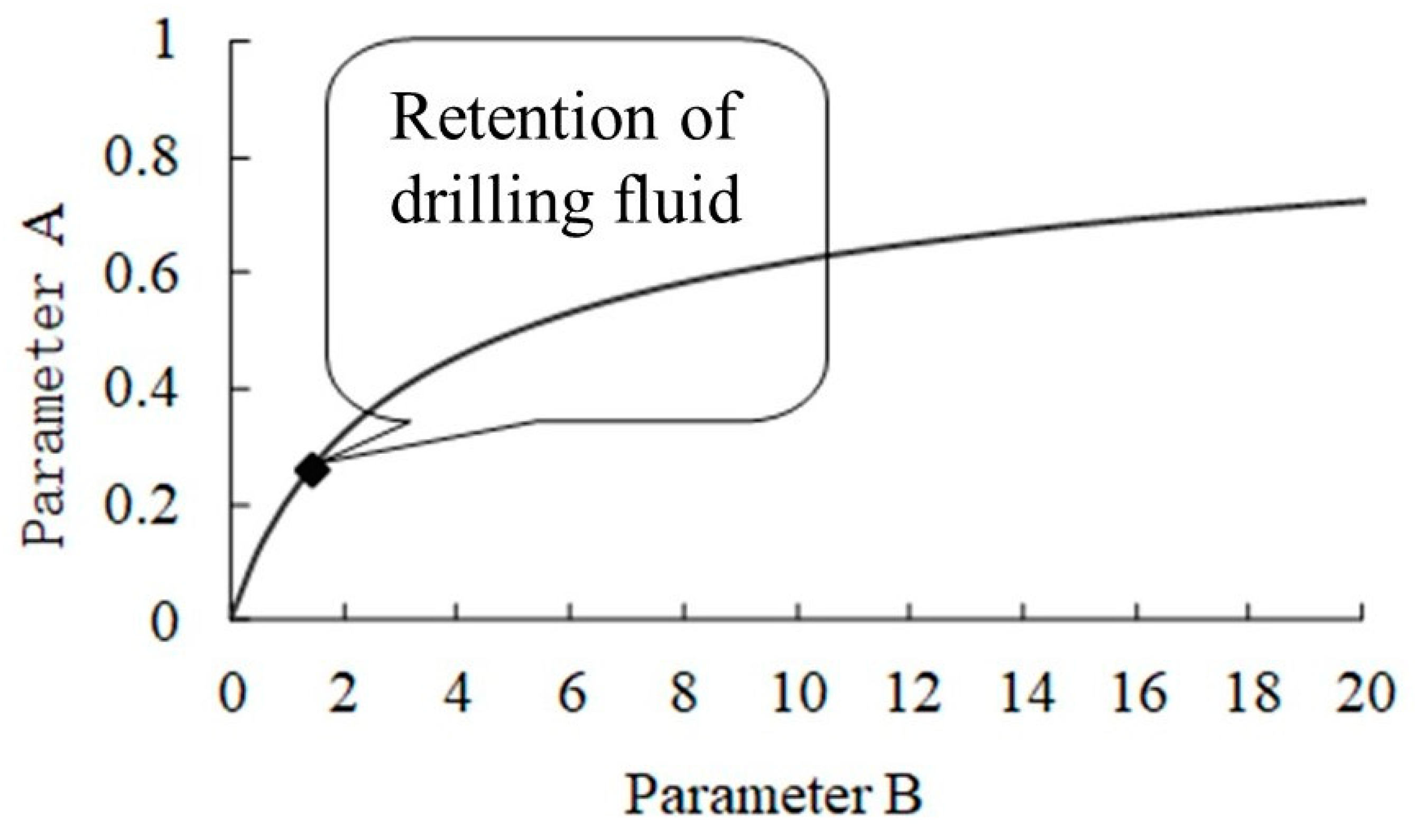
| Density (kg/3) | Liquidity Index | Consistency Coefficient (Pa·sn) | Dynamic Shear (Pa) | |
|---|---|---|---|---|
| Drilling fluid | 1200 | 1 | 0.3 | 6 |
| Cement slurry | 1500 | 1 | 0.45 | 4 |
| Fluid Property Parameters | Density (kg/m3) | Liquidity Index | Consistency Coefficient (Pa·sn) | Yield Stress (Pa) | A | B | |
|---|---|---|---|---|---|---|---|
| Drilling fluid | 1300 | 1 | 0.015 | 5 | --- | --- | |
| Pad fluid | Pad fluid #1 | 1400 | 0.67 | 0.082 | 1.738 | 0.348 | 1.047 |
| Pad fluid #2 | 1500 | 0.8679 | 0.044 | 2.563 | 0.513 | 1.183 | |
| Pad fluid #a | 1500 | 0.6 | 0.035 | 2 | 0.4 | 3.864 | |
| Pad fluid #b | 1500 | 0.8 | 0.025 | 1.5 | 0.3 | 1.653 | |
Disclaimer/Publisher’s Note: The statements, opinions and data contained in all publications are solely those of the individual author(s) and contributor(s) and not of MDPI and/or the editor(s). MDPI and/or the editor(s) disclaim responsibility for any injury to people or property resulting from any ideas, methods, instructions or products referred to in the content. |
© 2024 by the authors. Licensee MDPI, Basel, Switzerland. This article is an open access article distributed under the terms and conditions of the Creative Commons Attribution (CC BY) license (https://creativecommons.org/licenses/by/4.0/).
Share and Cite
Wu, Z.; Chen, Z.; Wang, C. Study of Retention of Drilling Fluid Layer on Annulus Wall during Cementing. Processes 2024, 12, 1176. https://doi.org/10.3390/pr12061176
Wu Z, Chen Z, Wang C. Study of Retention of Drilling Fluid Layer on Annulus Wall during Cementing. Processes. 2024; 12(6):1176. https://doi.org/10.3390/pr12061176
Chicago/Turabian StyleWu, Zhiqiang, Zehua Chen, and Chengwen Wang. 2024. "Study of Retention of Drilling Fluid Layer on Annulus Wall during Cementing" Processes 12, no. 6: 1176. https://doi.org/10.3390/pr12061176
APA StyleWu, Z., Chen, Z., & Wang, C. (2024). Study of Retention of Drilling Fluid Layer on Annulus Wall during Cementing. Processes, 12(6), 1176. https://doi.org/10.3390/pr12061176





